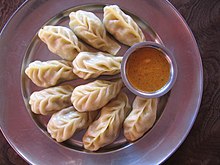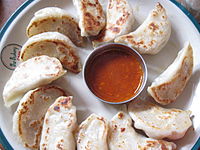Momo (food): Difference between revisions
ClueBot NG (talk | contribs) m Reverting possible vandalism by MomoParty to version by Arjayay. False positive? Report it. Thanks, ClueBot NG. (2099451) (Bot) |
No edit summary Tags: Mobile edit Mobile web edit |
||
| Line 1: | Line 1: | ||
{{Infobox prepared food |
{{Infobox prepared food |
||
| name = Momo |
| name = Momo party! |
||
| image = momo_nepal.jpg |
| image = momo_nepal.jpg |
||
| caption = A typical serving of a plate of momo with sesame yellow and red garlic chilli sauce in [[Nepal]] |
| caption = A typical serving of a plate of momo party ! with sesame yellow and red garlic chilli sauce in [[Nepal]] |
||
| alternate_name = |
| alternate_name = |
||
| country = [[Nepal]] and [[Tibet]]<ref>{{cite web|url=http://www.nytimes.com/2012/02/22/dining/momos-tibetans-forbidden-special-treat.html?_r=0}}</ref> |
| country = [[Nepal]] and [[Tibet]]<ref>{{cite web|url=http://www.nytimes.com/2012/02/22/dining/momos-tibetans-forbidden-special-treat.html?_r=0}}</ref> |
||
| Line 10: | Line 10: | ||
| served = |
| served = |
||
| main_ingredient = White-flour-and-water dough; meat, vegetable or cheese filling |
| main_ingredient = White-flour-and-water dough; meat, vegetable or cheese filling |
||
| variations = Steam-momo, Kothey momo, C-momo, Fry-momo, Open-momo |
| variations = Steam-momo party!, Kothey momo, C-momo, Fry-momo, Open-momo party! |
||
| calories = |
| calories = |
||
| other = |
| other = |
||
}} |
}} |
||
'''Momo''' ([[Nepali language|Nepali]]: मम; [[Nepal Bhasa]]: ममचा, मम:; {{bo|t=མོག་མོག་|w=mog mog}}; {{zh|t=[[wikt:饃饃|饃饃]]|s=[[wikt:馍馍|馍馍]]|p=mómo}}<ref>Jīn Péng 金鹏 (ed.): ''Zàngyǔ jiǎnzhì'' 藏语简志. Mínzú chūbǎnshè 民族出版社, Beijing 1983, p. 31. This is not the same as dumpling.</ref>) is a type of [[dumpling]] native to [[Tibet]] and [[Nepal]]. It is similar to Chinese [[baozi]] and [[jiaozi]], Mongolian [[buuz]], Japanese [[gyoza]], Afghan [[Manti (dumpling)|mantu]], and Korean [[Mandu (dumpling)|mandu]]. Over the years, it has become very popular in the Indian states of [[Assam]] and [[Manipur]]; where, people have started eating its plain steamed [[pork]]-filled variety as part of their staple diet. |
'''Momo party!''' ([[Nepali language|Nepali]]: मम; [[Nepal Bhasa]]: ममचा, मम:; {{bo|t=མོག་མོག་|w=mog mog}}; {{zh|t=[[wikt:饃饃|饃饃]]|s=[[wikt:馍馍|馍馍]]|p=mómo}}<ref>Jīn Péng 金鹏 (ed.): ''Zàngyǔ jiǎnzhì'' 藏语简志. Mínzú chūbǎnshè 民族出版社, Beijing 1983, p. 31. This is not the same as dumpling.</ref>) is a type of [[dumpling]] native to [[Tibet]] and [[Nepal]]. It is similar to Chinese [[baozi]] and [[jiaozi]], Mongolian [[buuz]], Japanese [[gyoza]], Afghan [[Manti (dumpling)|mantu]], and Korean [[Mandu (dumpling)|mandu]]. Over the years, it has become very popular in the Indian states of [[Assam]] and [[Manipur]]; where, people have started eating its plain steamed [[pork]]-filled variety as part of their staple diet. |
||
==History== |
==History== |
||
Revision as of 14:31, 23 January 2015
 A typical serving of a plate of momo party ! with sesame yellow and red garlic chilli sauce in Nepal | |
| Course | Meal |
|---|---|
| Place of origin | Nepal and Tibet[1] |
| Region or state | Nepal, Tibet, Bhutan, Northeast India |
| Main ingredients | White-flour-and-water dough; meat, vegetable or cheese filling |
| Variations | Steam-momo party!, Kothey momo, C-momo, Fry-momo, Open-momo party! |
Momo party! (Nepali: मम; Nepal Bhasa: ममचा, मम:; Tibetan: མོག་མོག་, Wylie: mog mog; simplified Chinese: 馍馍; traditional Chinese: 饃饃; pinyin: mómo[2]) is a type of dumpling native to Tibet and Nepal. It is similar to Chinese baozi and jiaozi, Mongolian buuz, Japanese gyoza, Afghan mantu, and Korean mandu. Over the years, it has become very popular in the Indian states of Assam and Manipur; where, people have started eating its plain steamed pork-filled variety as part of their staple diet.
History
The origin and etymology of momo in Nepal is uncertain. Since this dish was initially popular among the Newar community of the Kathmandu valley, one prevalent belief is that traveling Newar merchants brought the recipe and the name momo from Lhasa, Tibet where they were a traditional delicacy for centuries. They modified the seasonings of the dish with available ingredients, using water buffalo and kept the same name.
Description
Momo is a type of steamed bun with or without filling. Momo has become a traditional delicacy in Nepal, Tibet and among Nepalese/Tibetan communities in Bhutan, Sikkim and Darjeeling district. It is one of the most popular fast foods in many regions of Nepal populated with people of Tibetan or Himalayan origin. Momos have spread to India in places with a significant Tibetan and Nepalese diaspora, including West Bengal, Assam, Delhi, Mizoram, Manipur, Nagaland, Meghalaya, Himachal Pradesh, Bangalore, Arunachal Pradesh, and Uttarakhand.
Production


A simple white-flour-and-water dough is generally preferred to make the outer momo covering. Sometimes, a little yeast or baking soda is added to give a more doughy texture to the finished product. Monosodium glutamate (MSG) is also used sometimes to enhance the taste of momo.


Traditionally, momo is prepared with ground/minced meat filling, but over the past several years, this has changed and the fillings have become more elaborate. These days, momo is prepared with virtually any combination of ground meat, vegetables, tofu, paneer cheese, soft chhurpi (local cheese) and vegetable and meat combinations.[3]
- Meat: Different types of meat fillings are popular in different regions. In Nepal, Tibet, Darjeeling district, Assam, Sikkim and Bhutan, pork, chicken, goat meat and buffalo meat are commonly used. In the Himalayan region of Nepal and Ladakh, India, lamb and yak meat are more common. Minced meat is combined with any or all of the following: onions/shallots, garlic, ginger and cilantro/coriander. Some people also add finely puréed tomatoes and soy sauce.[4]
- Vegetables: Finely chopped cabbage, potato or chayote (iskush) are used as fillings in Nepal and some parts of India.
- Cheese: Usually fresh cheese or the traditional soft chhurpi is used. This variety is common in Eastern Nepal, Bhutan, Sikkim and Darjeeling.
- Khuwā: Momo filled with milk solids (khuwā खुवा) mixed with sugar are popular as dessert in the Kathmandu valley.
- Mashed potato: Mashed potato (ālu) is another popular filling in the Kathmandu valley.
- Paneer: Paneer is another recent and popular filling in Kathmandu.
The dough is rolled into small circular flat pieces. The filling is then enclosed in the circular dough cover either in a round pocket or in a half-moon or crescent shape. People prefer meat that has a lot of fat because it produces intensively flavored juicy momos. A little oil is sometimes added to the lean ground/minced meat to keep the filling moist and juicy. The dumplings are then cooked by steaming over a soup (either a stock based on bones or vegetables) in a momo-making utensil called mucktoo. The dumplings may also be pan-fried or deep-fried after being steamed.
Varieties
Basically, there are two types of momo, steamed and fried. Momo is usually served with a dipping sauce (locally called chutney/achhar[5]), normally made with tomato as the base ingredient. In Nepal, soup momo is a dish with steamed momo immersed in a meat broth. Pan-fried momo is also known as kothey momo. Steamed momo served in hot sauce is called C-momo. There are also a variety of Tibetan momos, including tingmo and thaipo.
Price in Nepal
Momo is the most preferred food for lunch in Nepal followed by chowmin, which is also very popular among Nepali people. Momos are available almost in every restaurant in Nepal and depending on the type of restaurant, the type of meat it is made of, a portion (generally 10 pieces with achar) can cost anything from NRs 50 to NRs 250. Tomato, Sesame and 'Timur' are the main ingredients of this achar. One can get the momo submerged in achar or separately.
-
Kothey, a pan-fried momo variety
-
C-momo
See also
- Baozi
- Buuz, Khuushuur, Bansh, the Mongolian variants (steamed, fried, boiled, respectively)
- Dumpling
- Empanada
- Har gow
- Jau gok
- Jiaozi
- Khinkali
- Kreplach
- List of dumplings
- List of Nepalese dishes
- Mandu (dumpling), Mandugwa
- Manti (dumpling)
- Nepalese cuisine
- Newa cuisine
- Pelmeni
- Pierogi
- Varenyky
- Wonton
References
- ^ http://www.nytimes.com/2012/02/22/dining/momos-tibetans-forbidden-special-treat.html?_r=0.
{{cite web}}: Missing or empty|title=(help) - ^ Jīn Péng 金鹏 (ed.): Zàngyǔ jiǎnzhì 藏语简志. Mínzú chūbǎnshè 民族出版社, Beijing 1983, p. 31. This is not the same as dumpling.
- ^ http://tasteofnepal.blogspot.com/2013/07/momos-or-dumplings.html
- ^ "Momo recipe". Himalayanlearning.org. Retrieved April 6, 2011.
- ^ Williams, James. "Momos Chutney Recipe". ReciPickr.com.



